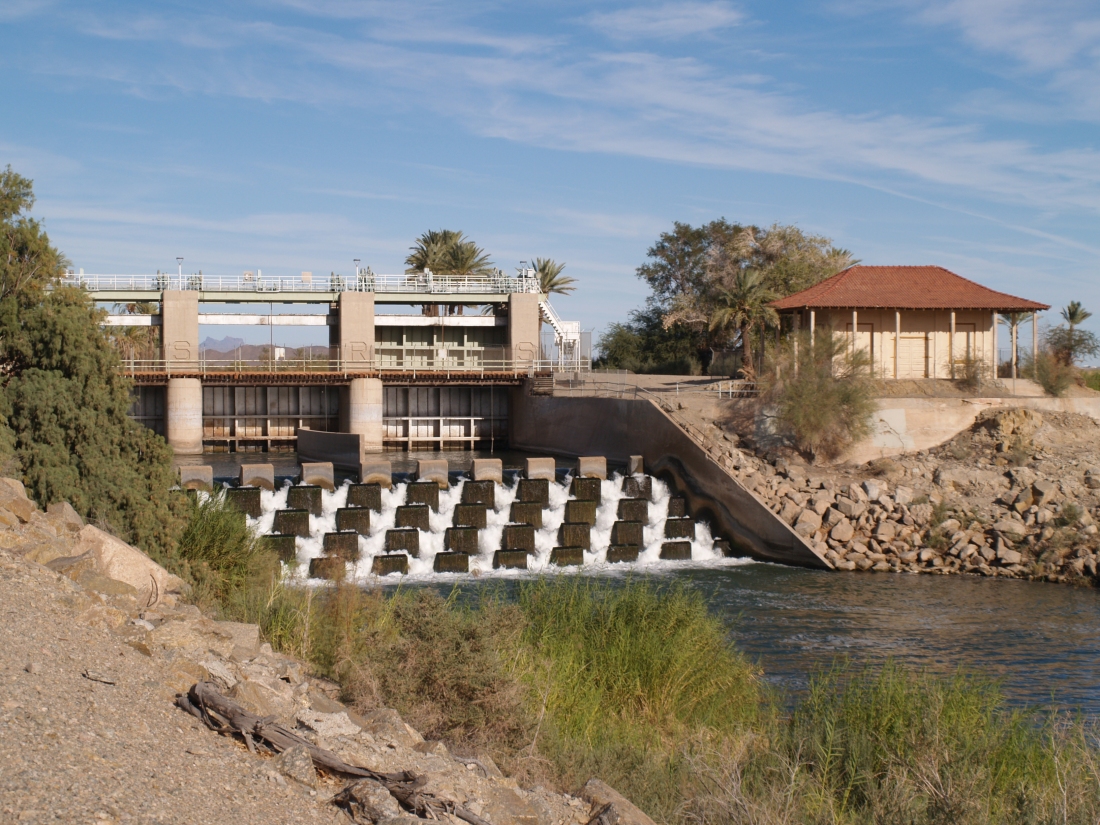
Sluiceway of Laguna Dam, 2017 photo by author
Construction of Laguna Dam, the first dam across the Colorado River, began in July 1905; plagued by contractor and supply problems, plus flooding, it was completed in March 1909. During its planning, core samples had shown the dam site was layer upon layer of silt carried down by the river over the ages, so a conventional dam design could not be used. US Reclamation Service engineers ultimately based the design on a weir dam on the Jumna (Yuamna) River in northern India that was successfully built on silt (USBR, 1902-1923, was the predecessor to the US Bureau of Reclamation).
Laguna Dam from California side, circa 1910 US Bureau of Reclamation photo, National Archives
Located north of Yuma, its principal gate (bottom width 116′) was built on the western (California) side of the river to divert water into a canal that carried water down the western side of the River until it was opposite the town of Yuma, where it was directed into a twelve foot siphon that went under the River to carry irrigation to the Yuma Valley in Arizona. Water was also diverted to Fort Yuma Resesrvation and the Bard Valley in California.

“Ground hags” working in the siphon during construction US Bureau of Reclamation photo, National Archives
Connected by a weir dam across the river bed that raised the water level 10–13 feet, on the eastern side was a smaller gate (bottom width 42′) and canal to carry water to agriculture in Arizona along the Gila River. Both sluicegates were based on bedrock & paved with concrete.

View of the Colorado River at Laguna today; California sluiceway is on the left. The white stretch of concrete across the river bed is the wier dam; the Arizona gateway is not visible to the left of the photo. The man-made “river” to the right is the All American Canal. US Bureau of Reclamation photo, Yuma project.

Sluiceway on the Arizona side, April 4, 1909. US Bureau of Reclamation photo

Sluiceway on the Arizona side, today. photo by the author
According to the Arizona Sun (2/2/2013), while studying Indian dam construction, the US Reclamation Service also learned about an ancient Hindu Goddess, who had the power to control water and was sometimes represented by a four armed swastika, a symbol that had a history of peace in many cultures going back 9,500-10,000 years; it was not until the 1930s when the Nazis adopted the symbol that it came to stand for evil. Near the eastern gate they built a concrete bridge adorned with swastikas (whirling counter-clockwise) and also some were incised on the sluiceway.

Swastika Bridge on the Arizona side photos by the author
In 1948, Imperial Dam replaced Laguna as the means to divert water to the Yuma Valley (as well as to the new All American Canal). Since then Laguna has served as a sluice gate and regulator for Imperial Dam releases through the main river channel to Mexico.
Much of the infomration in this segment is based on US Bureau of Reclamation and National Park Service sites, and articles in Engineering News, (February 27, 1908 & June 10, 1909) by Edwind D. Vincent, USBR Resident Engineer, Yuma Project.



Not many people see this little bridge on the Arizona side of Laguna Dam. I first saw it in 1973 when I was stationed at the Marine base there. Later in the 90’s revisited the area professionally (I worked for BuRec) and saw the little bridge that I saw decades earlier.
Laguna Dam has an interesting history as it was the first Dam on the Lower Colorado River. The structure is known as a diversion dam. Its main purpose was to impound enough water as to feed the two irrigation districts that it served. Another interesting fact is that Gold was discovered at the damsite on the California side during construction. One of California’s oldest Gold mines is located less than a mile from the dam. The other interesting thing about the dam is that it’s construction ended Steamboat travel on the river. Although the Searchlight once was carried over the earthen part of the dam.
In one of your photos you see USRS which was the original name of the Bureau of Reclamation. At that time it was a branch of the USGS and was known as the ‘Reclamation Service’. In the big picture, Laguna Dam became obsolete once the Imperial Dam (upstream) was built. Of course that is another great story you can tell us in the future.
LikeLike